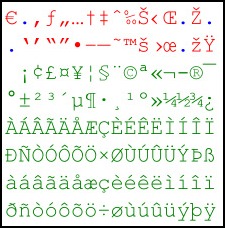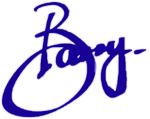Handy Hotkey: Alt+nnnn
Okay. This is not really a hotkey. It is more like a handy keyboard hint.
For most modern fonts there are far more characters available than fit on a standard keyboard.
Up until around the early-80s most computer-defined font sets contained just the 128 ASCII defined characters, which comprised of upper and lower case A through Z, a selection of special characters like !,#,&,%, and so on (mainly those that you find on the top row of the keyboard), and 32 non-printing ‘control’ characters.

These additional characters are shown in the graphic at right.
The problem here is that none of these characters has a corresponding key on a standard keyboard. So how do you use them?
There are a number of ways to use this second set of 128 characters. A small number of them are mapped automatically for you by Windows. For example if you do “( r )” without the spaces then Windows will automatically assume you wanted the ® character. Ditto for “( c )” and the © symbol. If you are in Microsoft Word and put three full stops together then Word will replace them with the proper ellipse character (…) and if you put two hyphens together then Word will replace them with a proper em dash (—).
But there is a more logical way to find and use these characters. That is by using the Alt+nnnn method. This method requires you to hold down the Alt key while entering four digits, always starting with zero, using the numeric keypad. The number is a number between 128 and 255 where character 128 is the character in the top left of the graphic above, and character 255 is the character at the bottom right (ÿ). The characters are numbered left to right, top to bottom.
The Alt+nnnn method will work in any Windows program provided that the font being used has the required characters defined (i.e., the full Windows-1252 character set is available). For well designed fonts such as Arial, Gorgia (this font), Times, Garamond, Calibri, etc., you can be sure that these extra 128 characters will be defined. For ‘cheaper’ or free fonts it is sometimes the case that the font designer could not be bothered describing and defining these addition characters. It takes time to define and refine each character in a font.
Here are some examples of using Alt+nnnn:
- Alt+0133 is … (proper ellipse)
- Alt+0135 is ‡ (double dagger)
- Alt+0150 is – (proper en dash)
- Alt+0151 is — (proper em dash)
- Alt+0153 is ™ (trademark)
- Alt+0165 is ¥ (Yen)
- Alt+0177 is ± (plus or minus)
- Alt+0181 is µ (micro)
- Alt+0186 is º (degree)
- Alt+0188 is ¼ (quarter)
- Alt+0189 is ½ (half)
- Alt+0190 is ¾ (three quarters)
- Alt+0223 is ß (beta)
- Alt+0225 is á (a with acute)
- Alt+0233 is é (e with acute)
- Alt+0247 is ÷ (divide)
These days there are actually a whole lot more characters and symbols available in most fonts. There are the Unicode extensions and include characters such as these:
Ω ∑ √ ≠ .
I will make a note to cover what these are and how to use them in a future posting.

